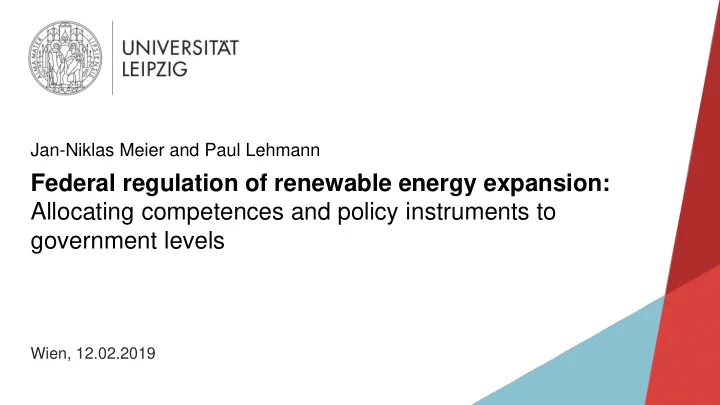

Jan-Niklas Meier and Paul Lehmann Federal regulation of renewable energy expansion: Allocating competences and policy instruments to government levels Wien, 12.02.2019
Outline Introduction & Research Question Literature & Innovation Model Results Conclusion Federal regulation of renewable energy expansion: Allocating competences and policy instruments 2
Introduction subject : expansion of renewable energy sources (RES) means positive global externalities (reduction of green house gas emissions) negative and positive regional externalities (wildlife, residents, landscape, and green preferences) Federal regulation of renewable energy expansion: Allocating competences and policy instruments 3
Introduction subject : expansion of renewable energy sources (RES) means positive global externalities (reduction of green house gas emissions) negative and positive regional externalities (wildlife, landscape, green preferences) problem : regulation of multiple externalities that simultaneously originate from RES deployment and take effect at different spatial scales answer : theory of fiscal federalism suggests match regulatory scale with spatial scale of externalities intergovernmental matching grants Federal regulation of renewable energy expansion: Allocating competences and policy instruments 4
Introduction & Research Question in practice: constrained choice of policy instruments : € national level : market-based instruments Market (nationwide RES expansion target) premium subnational level : spatial planning & command-and-control instruments (availability of sites for RES deployment) no explicit transfer mechanism among governmental regulators Federal regulation of renewable energy expansion: Allocating competences and policy instruments 5
Introduction & Research Question in practice: constrained choice of policy instruments : € national level : market-based instruments Market (nationwide RES expansion target) premium ≈ PRICE INCENTIVES subnational level : spatial planning & command-and-control instruments (availability of sites for RES deployment) ≈ CAPS no explicit transfer mechanism among governmental regulators Federal regulation of renewable energy expansion: Allocating competences and policy instruments 6
Introduction & Research Question in practice: constrained choice of policy instruments : € national level : market-based instruments Market (nationwide RES expansion target) premium ≈ PRICE INCENTIVES subnational level : spatial planning & command-and-control instruments (availability of sites for RES deployment) ≈ CAPS no explicit transfer mechanism among governmental regulators research question: Which government levels shall regulate RES expansion and which policy instrument shall they resort to? Federal regulation of renewable energy expansion: Allocating competences and policy instruments 7
Literature & Innovation Caplan and Silva (1997,1999): efficient regulation design hinges on assignment of policy instruments to government levels Williams III (2012): regulation of pollutant with local and national effects; welfare analysis of federal system where local and national regulators apply identical policy instruments Coria et al. (2018): extension of Williams III‘s (2012) with mixed policies; empirical analysis of stringency of local environmental policies in Sweden Innovation: welfare analysis of multi-level regulation with mixed policies Federal regulation of renewable energy expansion: Allocating competences and policy instruments 8
Model two levels of government governmental regulators are benevolent a sequential move game national price incentives are funded by subnational entities Federal regulation of renewable energy expansion: Allocating competences and policy instruments 9
Model Federal regulation of renewable energy expansion: Allocating competences and policy instruments 10
Model Federal regulation of renewable energy expansion: Allocating competences and policy instruments 11
Results national price incentives can work as intergovernmental matching grants → balancing free-riding and common-pool incentives for subnational entities efficient coordination depends on the burden sharing of national subsidy costs among subnational entities given uniform national policy, equally distributed cost sharing is in most instances welfare enhancing → if cost shares diverge, subnational policies even aggravate the inefficient uniform national policy and central regulation becomes preferable Federal regulation of renewable energy expansion: Allocating competences and policy instruments 12
Results Given equal burden sharing among subnational entities, federal regulation with expansion caps at the subnational level is better than central regulation → attenuates the deviation from first-best allocation that comes along with uniform subsidies at the national level Federal regulation of renewable energy expansion: Allocating competences and policy instruments 13
Conslusion Implications from our model results for the optimal design of RES regulation: transparency on and equality among states in burden sharing of national subsidy costs are desirable – in reality, this is not provided by the support scheme if cost shares are equally distributed: division of competences across government levels is preferable → in favor of federal regulation indifference between policy instruments at the subnational level if cost shares diverge and national policy is uniform: central regulation becomes welfare superior Federal regulation of renewable energy expansion: Allocating competences and policy instruments 14
Thank you for your attention! Jan-Niklas Meier University of Leipzig Ritterstraße 12 T +49 341 97-33604 meier@wifa.uni-leipzig.de https://home.uni-leipzig.de/multiplee
Results Federal regulation of renewable energy expansion: Allocating competences and policy instruments 16
Recommend
More recommend